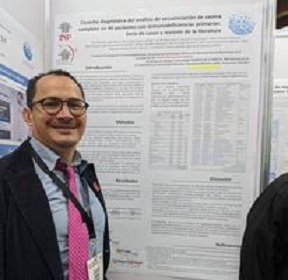Keynote Forum
MrSaul Oswaldo Lugo Reyes
Researcher in Medical Sciences Immunodeficiencies Research Unit 9th floor, Research Tower, National institute of pediatrics Coyoacan 04530 DF, MexicoTitle: Bioinformatic strategy and diagnostic yield of whole-exome sequencing in 124 patients with recurrent infections or autoimmunity.
Abstract:
The National Institute of Pediatrics is a referral center where we discuss and pursue the molecular and genetic diagnoses of patients with suspected inborn errors of immunity (IEI) from around the country. Since 2019, we process and analyze our own whole-exome sequencing (WES) results at the ID lab. Assessing our diagnostic yield as a measure of performance and quality control might help optimize processes, improve patient selection and resource allocation.
OBJECTIVE: To characterize our patients with suspected inborn errors of immunity and WES, to compare our diagnostic yield, and to identify attributes that might predict a positive diagnosis.
METHODS: Patients were diagnosed clinically and deemed high priority for sequencing by their clinicians. We obtained two FASTQ files per patient to complete the bioinformatic workflow using Galaxy for quality control, mapping & alignment of the reads, as well as variant detection, annotation, and filtering. We defined diagnostic yield as the proportion of patients with a genetic diagnosis after WES results analysis.
RESULTS: 124 patients from 27 states in Mexico, mean age 9.3 years (range 0.25-37 years), 56% male, 16% dead. In 56/124 (45%) analyzed exomes, we found rare pathogenic variants in at least one gene known to cause IEI that matched the patients’ phenotype and pertained to the IUIS 2020. In 5 others, a monogenic diagnosis different than IEI was found, for a final diagnostic yield of 61/124 (49%). In nearly half of the patients who had died before having their exomes analyzed, a genetic etiology was identified.
DISCUSSION: We describe our experience with 124 exomes at home, a first report from our country. Our results compare well with those from other centers. No feature by itself predicts a definitive diagnosis.
Biography:
Mr. Saul Oswaldo Lugo Reyes is a Researcher in Medical Sciences Immunodeficiencies Research Unit 9th floor, Research Tower, National institute of pediatrics Coyoacan 04530 DF, Mexico
Mr Ihteshamul Ihteshamul Haq
Kyunghee University South Korea pakistanTitle: Gene therapy
Abstract:
Gene therapy is an experimental technique that uses genes to treat or prevent disease. In the future, this technique may allow doctors to treat a disorder by inserting a gene into a patient’s cells instead of using drugs or surgery. Researchers are testing several approaches to gene therapy, although gene therapy is a promising treatment option for a number of diseases (including inherited disorders, some types of cancer, and certain viral infections), the technique remains risky and is still under study to make sure that it will be safe and effective. Gene therapy is currently being tested only for diseases that have no other cures. In the Coming Presentation I will Talk about the given below topic.
Biography:
Mr. Ihteshamul Ihteshamul Haq is a Ph.d Biotechnology Scholar Kyunghee University South Korea.He is from Pakistan,Hajara University.
Dr Rajoo Mal
Department of Veterinary Physiology and Biochemistry, Sindh Agriculture University, Tandojam, 70060, Sindh, PakistanTitle: Influence of dietary selenium supplementation on fermentation pattern and morphology in rumen of goat fed high concentrate diet
Abstract:
The present study investigated the fermentation pattern and morphological characteristics of rumen in goats fed high concentrate diet with or without selenium supplementation. A total of fifteen young goats were divided into three dietary groups, viz. LC, HC and HCS with 5 animals in each group either fed low concentrate (LC, roughage: concentrate ratio 65:35), high
concentrate (HC, 35:65) or HC plus Se (HCS) diets. Se was supplemented as selenium yeast at the dose rate of 0.3 mg Se/kg of diet. The experiment lasted for 10 weeks. Ruminal fluid and tissue samples were collected for analysis of fermentation pattern and histomorphometry. The fermentation pattern showed an increase in molar concentrations of acetate, propionate and butyrate in both HC and HCS groups compared to LC except for acetate that significantly decreased (P < 0.05) in HCS compared to HC. The drop in ruminal fluid pH was highly significant (P < 0.005) in HC fed than that of HCS fed (P < 0.05) goats compared to LC. Histomorphometric analysis showed severe damage concurrent with significant decrease in antioxidant enzymes in rumen epithelium of HC-fed goats compared to control, however, the selenium supplementation in HCS goats ameliorated the damaging effects of HC diet. The results of present study suggests that HC diet alters fermentation pattern and induces epithelial damage by increasing oxidative stress and the selenium supplementation ameliorates HC diet-induced epithelial damage in rumen of goat.
Key words: Selenium yeast, rumen epithelium, oxidative stress, epithelial damage, goat.
Biography:
He is from Department of Veterinary Physiology and Biochemistry, Sindh Agriculture University, Tandojam, 70060, Sindh, Pakistan.



